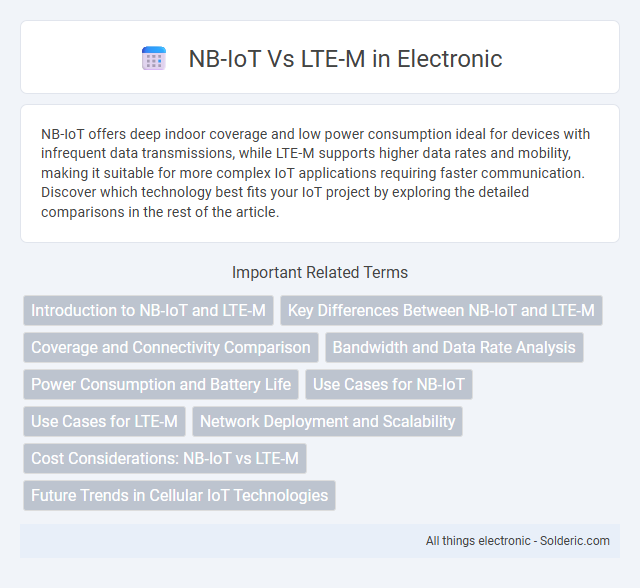NB-IoT offers deep indoor coverage and low power consumption ideal for devices with infrequent data transmissions, while LTE-M supports higher data rates and mobility, making it suitable for more complex IoT applications requiring faster communication. Discover which technology best fits your IoT project by exploring the detailed comparisons in the rest of the article.
Comparison Table
| Feature | NB-IoT | LTE-M |
|---|---|---|
| Technology | Narrowband Cellular IoT | Long-Term Evolution for Machines (LTE Cat M1) |
| Bandwidth | 180 kHz | 1.4 MHz |
| Data Rate | Up to 250 kbps | Up to 1 Mbps |
| Power Consumption | Ultra-low | Low to moderate |
| Coverage | Extended, up to 20 dB better indoor penetration | Extended, good mobility support |
| Mobility | Limited (primarily stationary) | Supported (including handover) |
| Latency | Higher latency (seconds) | Lower latency (milliseconds) |
| Use Cases | Smart metering, environmental monitoring, stationary sensors | Asset tracking, wearables, mobile IoT devices |
| Network Deployment | Uses existing LTE spectrum, can be deployed in-band, guard band or standalone | Operates within LTE spectrum, supports legacy LTE coexistence |
Introduction to NB-IoT and LTE-M
NB-IoT (Narrowband Internet of Things) and LTE-M (Long Term Evolution for Machines) are two leading cellular technologies designed specifically for IoT applications, offering reliable connectivity with low power consumption. NB-IoT provides enhanced indoor coverage and supports massive device deployments with low data rates, making it ideal for sensor networks and smart metering. LTE-M delivers higher data throughput and mobility, supporting voice communication and real-time applications, which makes it suitable for asset tracking and wearable devices.
Key Differences Between NB-IoT and LTE-M
NB-IoT offers better indoor coverage and lower power consumption, ideal for static IoT devices requiring extended battery life, while LTE-M supports higher data rates and mobility, suited for applications needing real-time communication and voice support. NB-IoT operates primarily on a narrow bandwidth of 200 kHz, whereas LTE-M uses a wider 1.4 MHz bandwidth, impacting throughput and latency. Your choice depends on deployment needs: NB-IoT fits low-data, long-duration use cases, and LTE-M excels in scenarios demanding moderate data transmission and mobility.
Coverage and Connectivity Comparison
NB-IoT offers superior indoor and underground coverage with up to 20 dB better link budget compared to LTE-M, making it ideal for deep coverage scenarios such as smart metering and asset tracking. LTE-M supports higher data rates and mobility with seamless handover, suitable for applications requiring real-time communication and device movement like wearables and fleet management. Both technologies operate on licensed spectrum but differ in power consumption and latency, influencing connectivity performance based on specific IoT use cases.
Bandwidth and Data Rate Analysis
NB-IoT operates with a narrow bandwidth of 180 kHz, enabling efficient communication for low data rate applications up to 250 kbps. LTE-M utilizes a wider bandwidth of 1.4 MHz, supporting higher data rates reaching 1 Mbps for more demanding IoT use cases. The bandwidth and data rate differences make NB-IoT ideal for low-power, infrequent data transmission, while LTE-M suits medium bandwidth and enhanced throughput requirements.
Power Consumption and Battery Life
NB-IoT typically offers lower power consumption compared to LTE-M, making it ideal for applications requiring extended battery life, sometimes lasting up to 10 years on a single charge. LTE-M supports higher data rates and mobility but consumes more energy, reducing battery life in power-constrained devices. Your choice between NB-IoT and LTE-M should consider the balance between data needs and the desired battery longevity for optimal performance.
Use Cases for NB-IoT
NB-IoT is ideal for low-power, wide-area applications such as smart metering, environmental monitoring, and asset tracking where long battery life and deep indoor coverage are essential. Its ability to support massive numbers of connected devices makes it perfect for large-scale IoT implementations like smart cities and industrial automation. Your choice of NB-IoT ensures reliable connectivity for devices requiring infrequent, small data transmissions over extended periods.
Use Cases for LTE-M
LTE-M supports a wide range of use cases including smart metering, asset tracking, wearable devices, and connected health applications due to its higher data throughput and mobility capabilities. It excels in scenarios requiring real-time communication and voice support, such as emergency response systems and vehicle telematics. With extended coverage and lower latency compared to NB-IoT, LTE-M is ideal for IoT applications needing reliable two-way communication and seamless handover in mobile environments.
Network Deployment and Scalability
NB-IoT offers extensive network deployment using existing LTE infrastructure with minimal modifications, enabling broad coverage in deep indoor and rural areas. LTE-M supports higher data rates and mobility, making it ideal for scalable IoT applications requiring seamless handovers and real-time communication. Your choice depends on scalability needs and network coverage priorities, with NB-IoT suited for massive, low-throughput device deployments and LTE-M for versatile, mobile IoT use cases.
Cost Considerations: NB-IoT vs LTE-M
NB-IoT generally offers lower device and module costs compared to LTE-M due to its simpler design and narrower bandwidth requirements, making it ideal for large-scale deployments of low-cost sensors. LTE-M supports higher data rates and mobility, which can increase both module prices and network expenses, but it provides better performance for applications requiring voice support or real-time communication. Your choice between NB-IoT and LTE-M should balance these cost considerations with the specific connectivity and power needs of your IoT use case.
Future Trends in Cellular IoT Technologies
NB-IoT offers ultra-low power consumption and enhanced coverage for IoT devices in remote areas, while LTE-M supports higher data rates and mobility for complex applications. Future trends in cellular IoT technologies emphasize seamless integration of 5G, improving network efficiency and expanding use cases in smart cities, industrial automation, and healthcare. Your choice between NB-IoT and LTE-M should align with specific connectivity requirements and anticipated advancements in cellular infrastructure.
NB-IoT vs LTE-M Infographic

 solderic.com
solderic.com